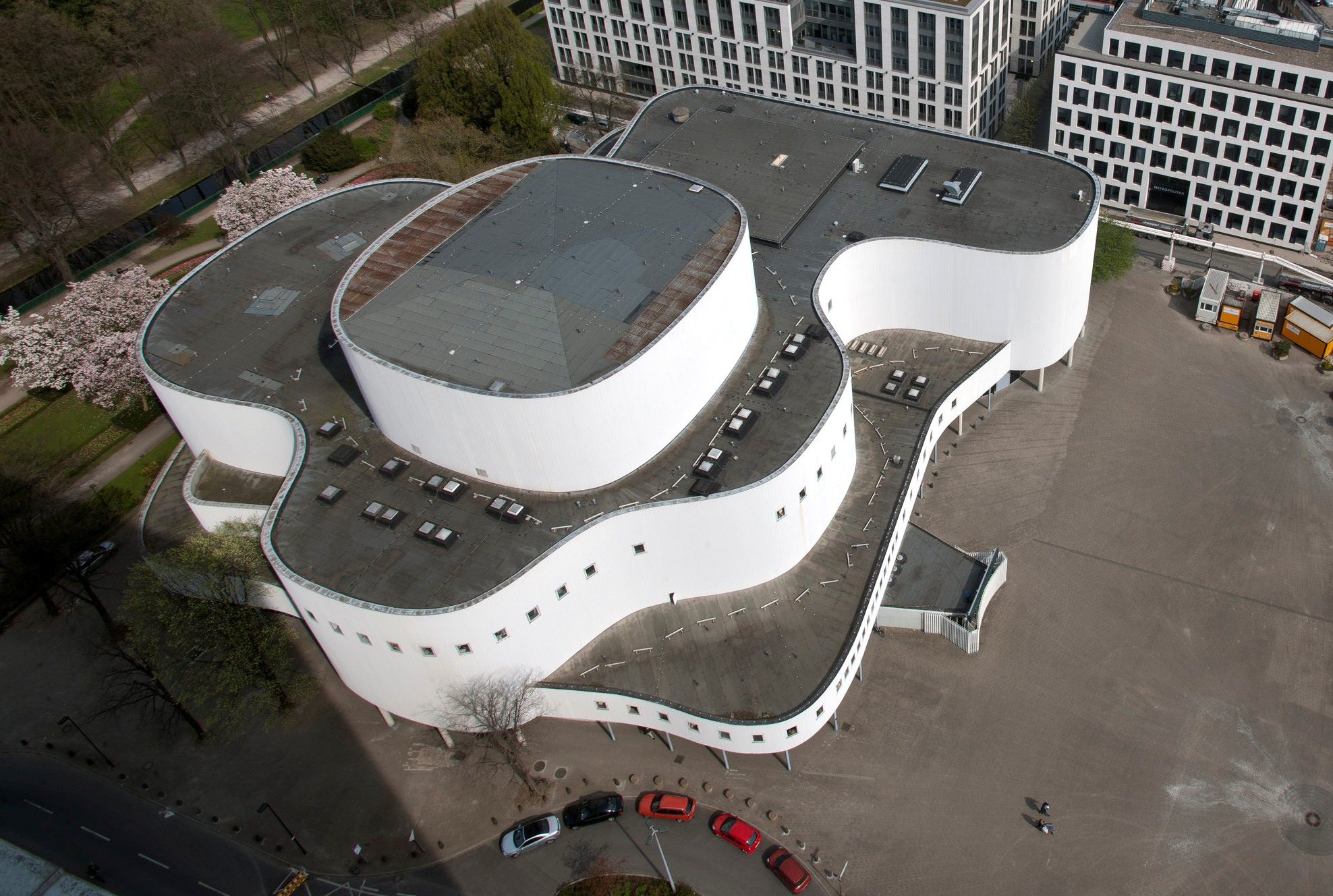Düsseldorfer Schauspielhaus on:
[Wikipedia]
[Google]
[Amazon]


 The is a theatre building and company in
The is a theatre building and company in
Düsseldorfer Schauspielhaus
Official website
Düsseldorfer Schauspielhaus
musenkuss-duesseldorf.de {{DEFAULTSORT:Dusseldorfer Schauspielhaus Theatres completed in 1969 Theatre companies in Germany Theatres in Düsseldorf Buildings and structures completed in 1969


 The is a theatre building and company in
The is a theatre building and company in Düsseldorf
Düsseldorf ( , , ; often in English sources; Low Franconian and Ripuarian language, Ripuarian: ''Düsseldörp'' ; archaic nl, Dusseldorp ) is the capital city of North Rhine-Westphalia, the most populous state of Germany. It is the second- ...
. The present building with two major auditoria was designed by the architect and built between 1965 and 1969. It opened in 1970.
History
The theatre dates back to 1747 when during the reign of elector Karl Theodor the ''Gießhaus'' was transformed to a theatre. In 1818Friedrich Wilhelm II Frederick William II may refer to:
* Frederick William II, Duke of Saxe-Altenburg (1603–1669)
* Frederick William II, Duke of Schleswig-Holstein-Sonderburg-Beck (1687–1749)
* Frederick William II, Prince of Nassau-Siegen (1706–1734)
* Frede ...
donated this building to the city of Düsseldorf. Josef Derossi was its first director, succeeded in 1834 by the poet Karl Leberecht Immermann. In 1905 a house dedicated to plays was opened by Louise Dumont
Louise Dumont (née Louise Maria Hubertine Heynen; 22 February 1862, in Cologne – 16 May 1932, in Düsseldorf) was a German actress and theater director.
Life
Louise Maria Hubertine Heynen, born on 22 February 1862 in Cologne near Neumark ...
and Gustav Lindemann who brought the house to fame.
After World War II Wolfgang Langhoff
Wolfgang Langhoff (6 October 1901 in Berlin, German Empire – 26 August 1966 in Berlin, German Democratic Republic)The Internet Movie Database"Wolfgang Langhoff" Accessed 17 August 2007. was a German theatre, film and television actor and theat ...
was the first director, succeeded in 1946 by Gustaf Gründgens
Gustaf Gründgens (; 22 December 1899 – 7 October 1963), born Gustav Heinrich Arnold Gründgens, was one of Germany's most famous and influential actors of the 20th century, and artistic director of theatres in Berlin, Düsseldorf, and Hamburg ...
. His directions made the house one of the most important stages in Europe. In 1955 he was succeeded by Karl Heinz Stroux.
Present building
The present theatre was commissioned by the city of Düsseldorf during the tenure of Stroux. The ''Operettenhaus'', which had served as a venue for performance of plays after World War II, proved too limited. In 1957 a new building was proposed, for which the site, on Gustaf-Gründgens-Platz, was secured in 1958. An international competition was held in 1959 and won by Pfau. The theatre is designed like a sculpture, juxtaposed to the nearby Dreischeibenhaus. The style has been described asorganic architecture
Organic architecture is a philosophy of architecture which promotes harmony between human habitation and the natural world. This is achieved through design approaches that aim to be sympathetic and well-integrated with a site, so buildings, furn ...
. The great hall (''Großes Haus'') seated 900 people then (now 760), the small hall (''Kleines Haus'') 300.
Construction took place from 1965 to 1969, and the theatre opened on 16 January 1970 with a performance of Georg Büchner
Karl Georg Büchner (17 October 1813 – 19 February 1837) was a German dramatist and writer of poetry and prose, considered part of the Young Germany movement. He was also a revolutionary and the brother of physician and philosopher Ludwig Büch ...
's ''Dantons Tod
' (German for ''Danton's Death'') is an opera by Gottfried von Einem to a libretto by Boris Blacher and Gottfried von Einem after Georg Büchner's 1835 play of the same name. Its first performance took place in Salzburg on 6 August 1947. It was ...
''.
In 1972 Ulrich Brecht succeeded Stroux as director, followed in 1974 by Günter Beelitz, then Volker Canaris. In 1996 Anna Badora was director, succeeded in 2006 by Amélie Niermeyer. Staffan Valdemar Holm was director from 2011, with four venues, ''Großes Haus'', ''Kleines Haus'', ''Junges Schauspielhaus'' (Young play house) and ''Central''.
References
Literature
* Claudia Elbert: ''Die Theater Friedrich Weinbrenners. Bauten und Entwürfe.'' Karlsruhe 1988, . * Clemens Klemmer: ''Meister der Moderne. Der Düsseldorfer Architekt Bernhard Pfau.'' In: Verlegergemeinschaft Werk, Bauen + Wohnen, 75.11,1988, S. 84–86. * Hannelore Schubert: ''Moderner Theaterbau. Internationale Stationen, Dokumentationen, Projekte, Bühnentechnik.'' Stuttgart 1971, , S. 168–170. * Hans Schwab-Felisch: ''Das Düsseldorfer Schauspielhaus mit 135 Abbildungen.'' Düsseldorf 1970, . * Hans Schwab-Felisch: ''Fünfundsiebzig Jahre Düsseldorfer Schauspielhaus 1905–1980.'' . * Julius Niederwöhrmeier: ''Das Lebenswerk des Düsseldorfer Architekten Bernhard Pfau 1902–1989.'' Stuttgart 1997, , S. 263–292. * Markus Brüderlin (Hrsg.): ''Archiskulptur. Dialoge zwischen Architektur und Plastik vom 18. Jahrhundert bis heute.'' Ausst. Kat. 3. Oktober 2004–30. Januar 2005 in der Fondation Beyeler in Riehen. Basel, Ostfildern-Ruit 2004, * Paul Ernst Wentz: ''Architekturführer Düsseldorf.'' Düsseldorf 1975, Objektnr. 12, . * Peter Adamski: ''Mutation.'' In: Stattzeitung Nr. 165 (September 1989) S. 4–5. * Winrich Meiszies (Hrsg.): ''Jahrhundert des Schauspiels. Vom Schauspielhaus Düsseldorf zum Düsseldorfer Schauspielhaus.'' Düsseldorf 2006, , S. 7–31/149–155/182–187.Reference in software
A picture of the top of the Düsseldorfer Schauspielhaus is included as a desktop background, under section "Architecture" in the Windows 7 operating system (picture img15.jpg).External links
Düsseldorfer Schauspielhaus
Official website
Düsseldorfer Schauspielhaus
musenkuss-duesseldorf.de {{DEFAULTSORT:Dusseldorfer Schauspielhaus Theatres completed in 1969 Theatre companies in Germany Theatres in Düsseldorf Buildings and structures completed in 1969